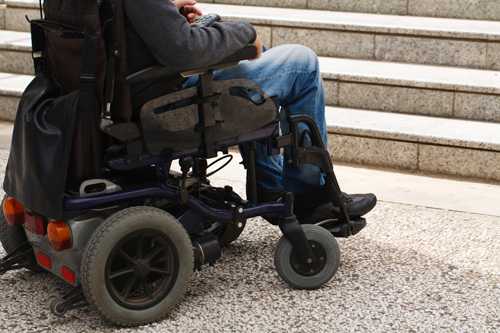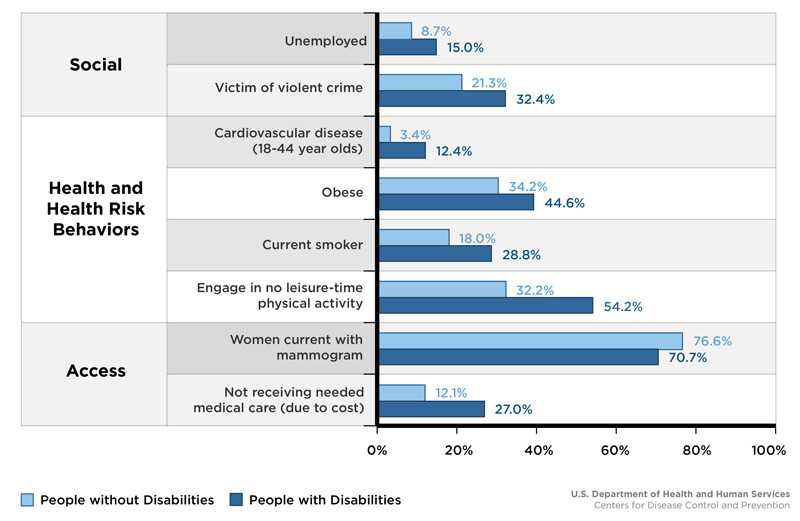Common Barriers to Participation Experienced by People with Disabilities

Nearly everyone faces hardships and difficulties at one time or another. But for people with disabilities, barriers can be more frequent and have greater impact. The World Health Organization (WHO) describes barriers as being more than just physical obstacles. Here is the WHO definition of barriers:
“Factors in a person’s environment that, through their absence or presence, limit functioning and create disability. These include aspects such as:
- a physical environment that is not accessible,
- lack of relevant assistive technology (assistive, adaptive, and rehabilitative devices),
- negative attitudes of people towards disability,
- services, systems and policies that are either nonexistent or that hinder the involvement of all people with a health condition in all areas of life.” 1
Often there are multiple barriers that can make it extremely difficult or even impossible for people with disabilities to function. Here are the seven most common barriers. Often, more than one barrier occurs at a time.
Attitudinal barriers
Attitudinal barriers are the most basic and contribute to other barriers. For example, some people may not be aware that difficulties in getting to or into a place can limit a person with a disability from participating in everyday life and common daily activities. Examples of attitudinal barriers include:
- Stereotyping: People sometimes stereotype those with disabilities, assuming their quality of life is poor or that they are unhealthy because of their impairments.
- Stigma, prejudice, and discrimination: Within society, these attitudes may come from people’s ideas related to disability—People may see disability as a personal tragedy, as something that needs to be cured or prevented, as a punishment for wrongdoing, or as an indication of the lack of ability to behave as expected in society.
Today, society’s understanding of disability is improving as we recognize “disability” as what occurs when a person’s functional needs are not addressed in his or her physical and social environment. By not considering disability a personal deficit or shortcoming, and instead thinking of it as a social responsibility in which all people can be supported to live independent and full lives, it becomes easier to recognize and address challenges that all people–including those with disabilities–experience.
Communication Barriers
Communication barriers are experienced by people who have disabilities that affect hearing, speaking, reading, writing, and or understanding, and who use different ways to communicate than people who do not have these disabilities. Examples of communication barriers include:
- Written health promotion messages with barriers that prevent people with vision impairments from receiving the message. These include
- Use of small print or no large-print versions of material, and
- No Braille or versions for people who use screen readers.
- Auditory health messages may be inaccessible to people with hearing impairments, including
- Videos that do not include captioning, and
- Oral communications without accompanying manual interpretation (such as, American Sign Language).
- The use of technical language, long sentences, and words with many syllables may be significant barriers to understanding for people with cognitive impairments.
Physical barriers
Physical barriers are structural obstacles in natural or manmade environments that prevent or block mobility (moving around in the environment) or access. Examples of physical barriers include:
- Steps and curbs that block a person with mobility impairment from entering a building or using a sidewalk;
- Mammography equipment that requires a woman with mobility impairment to stand; and
- Absence of a weight scale that accommodates wheelchairs or others who have difficulty stepping up.
Policy Barriers
Policy barriers are frequently related to a lack of awareness or enforcement of existing laws and regulations that require programs and activities be accessible to people with disabilities.2 Examples of policy barriers include:
- Denying qualified individuals with disabilities the opportunity to participate in or benefit from federally funded programs, services, or other benefits;
- Denying individuals with disabilities access to programs, services, benefits, or opportunities to participate as a result of physical barriers; and
- Denying reasonable accommodations to qualified individuals with disabilities, so they can perform the essential functions of the job for which they have applied or have been hired to perform.
Programmatic Barriers
Programmatic barriers limit the effective delivery of a public health or healthcare program for people with different types of impairments. Examples of programmatic barriers include:
- Inconvenient scheduling;
- Lack of accessible equipment (such as mammography screening equipment);
- Insufficient time set aside for medical examination and procedures;
- Little or no communication with patients or participants; and
- Provider’s attitudes, knowledge, and understanding of people with disabilities.
Social Barriers
Social barriers are related to the conditions in which people are born, grow, live, learn, work and age – or social determinants of health – that can contribute to decreased functioning among people with disabilities. Here are examples of social barriers:
- People with disabilities are far less likely to be employed. The unemployment rate in 2012 for people with disabilities was more than 1 in 10 (13.9%) compared to less than 1 in 10 (6.0%) for those without disabilities.3
- Adults age 25 years and older with disabilities are less likely to have completed high school compared to their peers without disabilities (23.5% compared to 11.1%).
- People with disabilities are more likely to live in poverty compared to people without disabilities (21.6% compare to 12.8%).4
- Children with disabilities are almost four times more likely to experience violence than children without disabilities.5
Factors Affecting the Health of People with Disabilities and without Disabilities6

Transportation barriers
Transportation barriers are due to a lack of adequate transportation that interferes with a person’s ability to be independent and to function in society. Examples of transportation barriers include:
- Lack of access to accessible or convenient transportation for people who are not able to drive because of vision or cognitive impairments, and
- Public transportation may be unavailable or at inconvenient distances or locations.
References
- World Health Organization, International classification of functioning, disability and health. Geneva:2001, WHO. p. 214.
- Source: (http://www.hhs.gov/ocr/civilrights/resources/factsheets/504.pdf).
- Source: U.S. Bureau of Labor Statistics, 2014); available at http://www.bls.gov/news.release/disabl.a.htm
- Source: U.S. Census, American Community Survey, 2013.
- Source: World Health Organization; available at http://www.who.int/mediacentre/news/notes/2012/child_disabilities_violence_20120712/en/
- Gloria L. Krahn, Deborah Klein Walker, and Rosaly Correa-De-Araujo. Persons With Disabilities as an Unrecognized Health Disparity Population. American Journal of Public Health: April 2015, Vol. 105, No. S2, pp. S198-S206.
- Page last reviewed: August 1, 2017
- Page last updated: March 17, 2016
- Content source:




 ShareCompartir
ShareCompartir